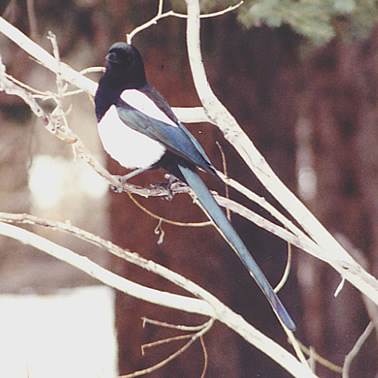English
magpieArapaho
woo'úh'eiLocation
anywhere except the higher mountains.
Magpies and the Arapaho
The magpie ranks just behind the Eagle as perhaps the most important of all birds for the Arapaho in ceremonial uses. It was admired for its handsome appearance and swift flight, and especially for the way in bravely flew into camp and made off with food, like a successful Indian raider. Its feathers were not used that often in more traditional ceremonies, despite the general admiration, but they were very widely used in creating ritual objects used in the Ghost Dance. The subsequent, modified version of the Ghost Dance called the Crow Dance also featured many items made of magpie feathers. As part of the Crow Dance, the dancers actually imitated magpies, rushing forward to dip their fingers in a ceremonial stew, then rushing away again (Kroeber, The Arapaho, p. 367). Due to its swift flight, the magpie and its feathers were also indirectly associated with the Thunderbird, and the black-and-white feathers of the magpie were used to represent storm clouds (Kroeber, The Arapaho, p. 352).
The Arapaho have always been interested in birds with iridescent feathers (crows and grackles being two other birds whose feathers are used ceremonially). The sheen of the feathers is understood as capturing the light of the sun, and thus birds with this coloring are seen as symbolically powerful. In addition, black is the color of victory, and this may play a part in the value given to black birds, but this supposition has not been verified with elders.
